Almost four in five marketers say their overall customer journey is at least partially automated, according to research from Ascend2.
And the #1 use of marketing automation software?
Email marketing.
Not only is it the most popular form of marketing automation; it’s also one of the fastest-growing, with uptake increasing from 40 percent in 2021 to 55 percent in 2022.
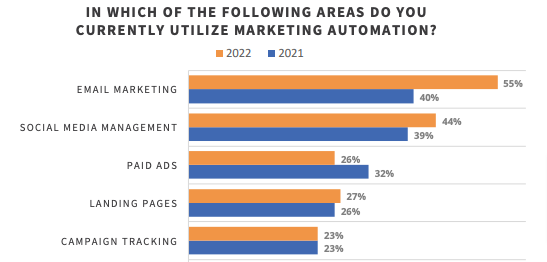 Which brings us neatly to ActiveCampaign, an email marketing, automation, and CRM platform used by over 180,000 businesses in 170+ countries.
Which brings us neatly to ActiveCampaign, an email marketing, automation, and CRM platform used by over 180,000 businesses in 170+ countries.
It’s a fantastic tool. But with so many ActiveCampaign alternatives available, how can you be certain you’re making the right choice?
The only way to be sure is to thoroughly compare ActiveCampaign to the myriad other platforms on the market.
That takes a heap of time. But we’ve done the leg work for you by comparing the 10 best ActiveCampaign alternatives across multiple criteria:
- Price
- Product features
- Customer support
- Pros and cons
- Target audience
Let’s get into it…
What Are the Best ActiveCampaign Alternatives?
| ActiveCampaign Alternatives | Best For | Top Features | Pricing/Month |
| Drip | DTC ecommerce | Segment your whole audience based on real-time store, visitor, and marketing data. | From $39 per month for up to 2,500 contacts and unlimited email sends. |
| Klaviyo | Ecommerce agencies and developers | Personalization and segmentation tools allow you to create customer segments based on real-time data. | Free for up to 250 contacts and 500 monthly email sends; paid plans priced from $45 per month for up to 1,000 contacts and 10,000 monthly email sends. |
| Mailchimp | Small businesses | Advanced analytics and reporting help marketers make data-driven decisions. | Free for up to 500 contacts and 1,000 monthly email sends; paid plans start at $9.99 per month for 500 contacts and 5,000 monthly email sends. |
| Omnisend | Ecommerce marketers | Web push notifications allow brands to instantly retarget customers. | Free to reach up to 250 contacts per month, including 500 monthly email sends, up to 60 SMS messages, and up to 500 web push notifications. Paid plans start at $16 per month to reach up to 500 contacts (including unlimited push notifications). |
| AWeber | Startups and small businesses | Create email templates in seconds using your website or Facebook page URL. | Free for up to 500 email subscribers and 3,000 monthly email sends; paid plans priced from $16.15 per month for up to 2,500 subscribers. |
| ConvertKit | Content creators | Integrated newsletter referral program helps creators grow their reach by leveraging their existing audience. | Free for up to 1,000 subscribers and unlimited email sends; paid plans start at $9 per month for up to 300 subscribers and unlimited sends. |
| Sendinblue | Low-budget email marketing | Send transactional emails with guaranteed 97 percent deliverability. | Free for unlimited contacts and up to 300 emails per day. Paid plans start at $25 per month for unlimited contacts and 20,000 emails per month. |
| Constant Contact | Nonprofits and charities | Manage campaigns on the go from a dedicated mobile app. | From $9.99 per month for up to 500 contacts and 12,000 monthly email sends. |
| GetResponse | Small businesses that need advanced marketing tools | Built-in support for live and on-demand webinars. | Free for up to 500 contacts and 2,500 monthly email sends. Paid plans start at $15.58 per month for 1,000 contacts and unlimited email sends. |
| HubSpot | B2B inbound marketing | Connect marketing, sales, content management, and customer service in a single platform. | Free marketing plan includes unlimited contacts and 2,000 monthly email sends. Paid marketing plans start at $18 per month for 1,000 contacts and 5,000 monthly sends. |
The 10 Best ActiveCampaign Alternatives:
1. Drip
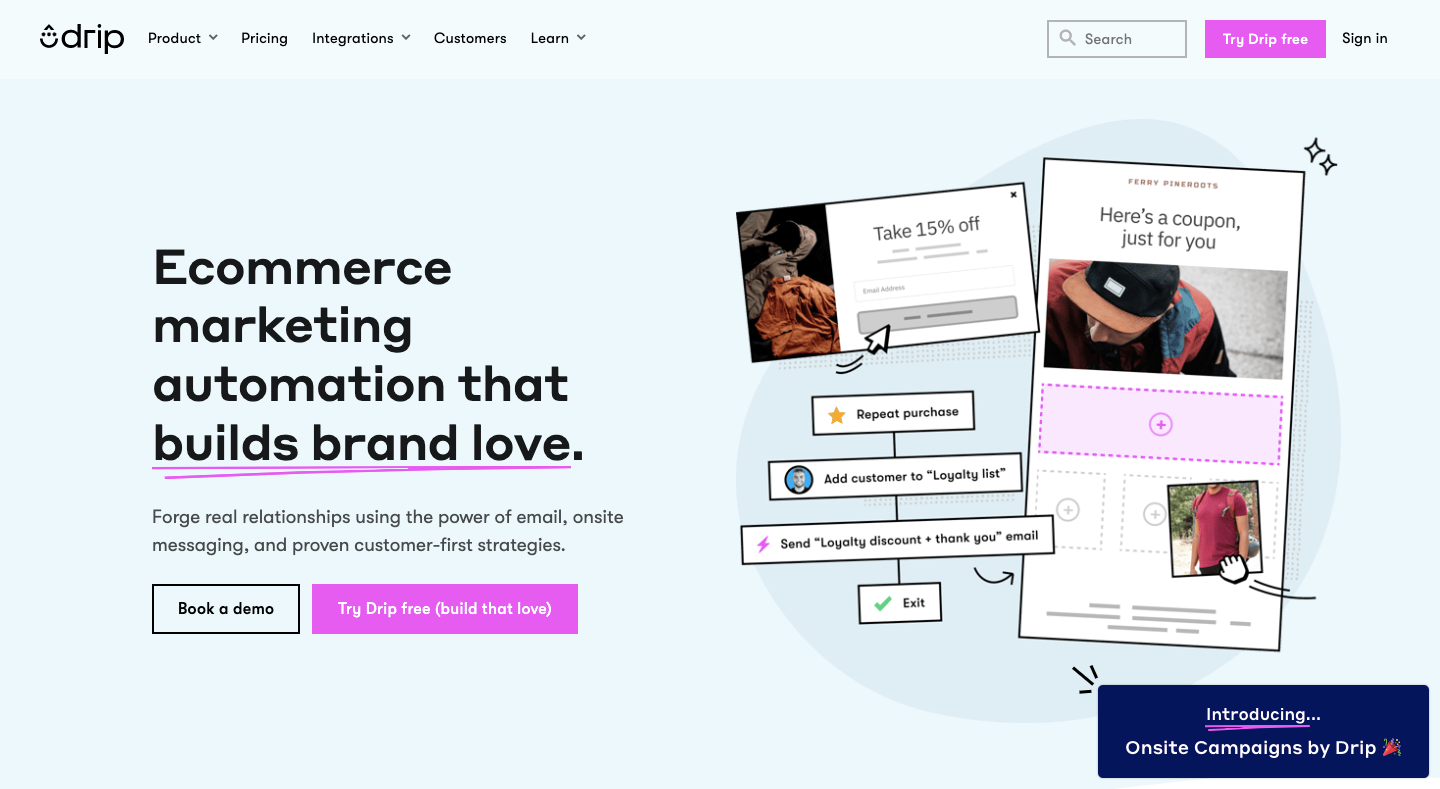 Drip is an ecommerce marketing automation tool for DTC brands who need to deliver personalized customer journeys at scale. We provide you with email marketing, onsite tools, and integrations with third-party platforms so that you can get the most out of your ecommerce activities.
Drip is an ecommerce marketing automation tool for DTC brands who need to deliver personalized customer journeys at scale. We provide you with email marketing, onsite tools, and integrations with third-party platforms so that you can get the most out of your ecommerce activities.
What Makes Drip the Best ActiveCampaign Alternative?
- Built for ecommerce. If you’re in DTC ecommerce, Drip is the obvious choice. ActiveCampaign’s functionality is designed for sales teams. But the challenges of ecommerce are fundamentally different to those of enterprise SaaS or B2B brands.
- Ecommerce-focused product development. Drip is built explicitly for DTC ecommerce brands, incorporating out-of-the-box revenue attribution, pre-built workflow templates, 50+ email templates, ecommerce integrations, and much more. We’ll continue developing our product to better meet the needs of DTC ecommerce brands, because they’re our sole focus. ActiveCampaign—with its wider range of target industries and use cases—likely won’t do the same.
- Superior onsite marketing. Our addition of feature-rich form and popup-building platform Sleeknote (now integrated in Drip as Onsite) gives us a wealth of onsite functionality that ActiveCampaign simply can’t match, including gamification and personalization.
- Support tailored to your brand. ActiveCampaign only offers customized marketing strategies with quarterly updates for customers on their Enterprise plan, which is significantly more expensive than Drip. Meanwhile, at Drip, we pride ourselves on customized support. We’ll pull up a chair next to you and help with everything from onboarding to custom strategy recommendations to quarterly business reviews—whatever it takes to help you make the most of our platform. We even offer content services.
- Focused on revenue. We know revenue growth is the be-all and end-all for DTC ecommerce businesses. To that end, we provide revenue metrics for every email and automation, and even show you Drip-attributed revenue—so you know exactly how much you’re getting out of our tool. We also offer monthly reports centered on ecommerce strategies, helping you understand what’s going well and what needs improving. On the flip side, ActiveCampaign is more focused on customer engagement.
- Simple, beautiful UI. Our user interface makes it easy to leverage all the tools, data, and automations DTC ecommerce brands need to hit their growth goals. Inevitably, ActiveCampaign is a lot more cluttered, because it serves a far broader audience.
How Does Drip Compare to ActiveCampaign?
| Drip | ActiveCampaign | |
| Best Feature | Segment your whole audience based on real-time store, visitor, and marketing data. | Predictive actions use machine learning to deliver customer experiences based on data, such as the best time to send emails. |
| Best For | DTC ecommerce | Advanced marketers who need high-level automation |
| Pros | Built for ecommerce marketers, not B2B sales teams. | Sophisticated automations with a broad range of use cases. |
| Cons | If you’re not in ecommerce, Drip isn’t the best fit. | Harder to use; less focus on revenue growth. |
| Pricing/Month | From $39 per month for up to 2,500 contacts and unlimited email sends. | From $29 per month for one user and unlimited emails. |
| Support | Our support is rated 8.8 on G2 (vs. an average of 8.6 for marketing automation platforms) and includes live audio screen sharing to solve problems in real time. | All ActiveCampaign plans offer 24/7 email and chat-based support, but only Enterprise customers get over-the-phone support. |
Is Drip for you? Check out how much Drip would cost with your email list size:
Included in price:
- 1-2,500 people
- Unlimited email sends
2. Klaviyo
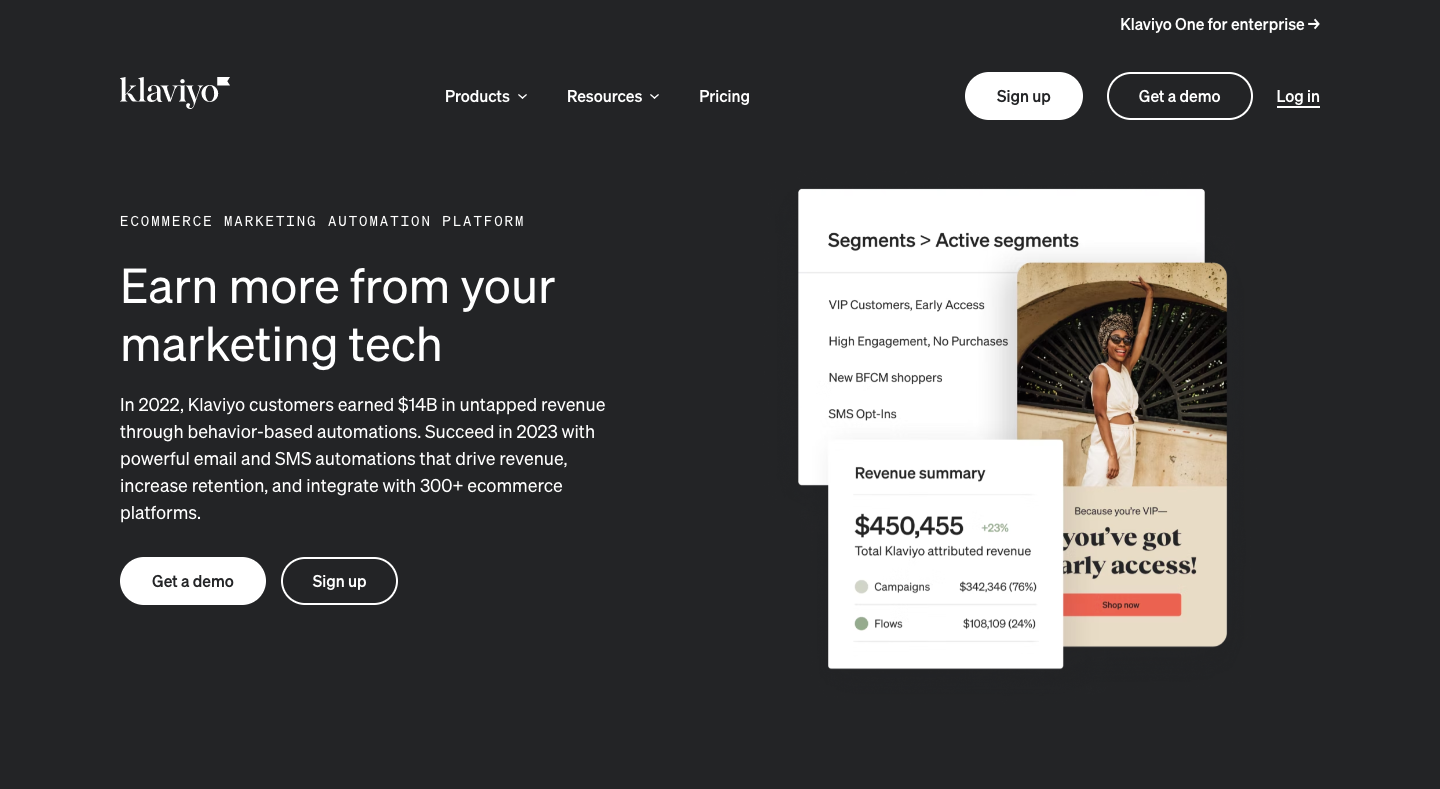 Klaviyo is a popular ecommerce marketing system that allows customers to run automated campaigns via email or SMS. It has been adopted by a wide range of businesses—from startups to big Fortune 500 retailers—in over 80 countries, with more than 100,000 paid users.
Klaviyo is a popular ecommerce marketing system that allows customers to run automated campaigns via email or SMS. It has been adopted by a wide range of businesses—from startups to big Fortune 500 retailers—in over 80 countries, with more than 100,000 paid users.
What Makes Klaviyo the Best ActiveCampaign Alternative?
- Built for ecommerce businesses. Just like Drip, Klaviyo is solely focused on ecommerce automation. By contrast, ecommerce is one of over a dozen niches that ActiveCampaign serves.
- Free product tier. Klaviyo doesn’t offer the most generous free plan of all the ActiveCampaign alternatives we’ve analyzed, with up to 250 contacts and 500 monthly email sends. But it’s better than nothing and helps you get to grips with the platform’s functionality. ActiveCampaign doesn’t have a free tier.
- Ecommerce-focused CRM. Klaviyo effectively offers a built-in CRM platform catered to ecommerce businesses, helping users gain a deeper understanding of customer behaviors and preferences. ActiveCampaign’s CRM is excellent, but it’s designed for sales teams rather than ecommerce marketers.
- Detailed ecommerce dashboard. ActiveCampaign’s dashboard lacks the hard, revenue-oriented data ecommerce businesses require to guide decision-making. Klaviyo is far superior here, showing store revenue, revenue per automation, and revenue per campaign.
- Dynamic product feeds. Both platforms offer excellent campaign builders, but Klaviyo allows you to set up a dynamic feed based on specific criteria, like product category or best-sellers. That way, you don’t need to update your emails every time you launch a new product.
How Does Klaviyo Compare to ActiveCampaign?
| Klaviyo | ActiveCampaign | |
| Best Feature | Personalization and segmentation tools allow you to create customer segments based on real-time data. | Predictive actions use machine learning to deliver customer experiences based on data, such as the best time to send emails. |
| Best For | Ecommerce agencies and developers | Advanced marketers who need high-level automation |
| Pros | Sophisticated ecommerce features and reporting. | Built for sales and marketing teams, not developers and agencies. |
| Cons | Requires advanced technical skills (or, ideally, a full-service Klaviyo agency) to use it effectively. | Lacks the ecommerce-focused UI and features of a dedicated platform. |
| Pricing/Month | Free for up to 250 contacts and 500 monthly email sends; paid plans priced from $45 per month for up to 1,000 contacts and 10,000 monthly email sends. | From $29 per month for one user and unlimited emails. |
| Support | After the extensive onboarding program, support is limited to live chat and emails. | All ActiveCampaign plans offer 24/7 email and chat-based support, but only Enterprise customers get over-the-phone support. |
3. Mailchimp
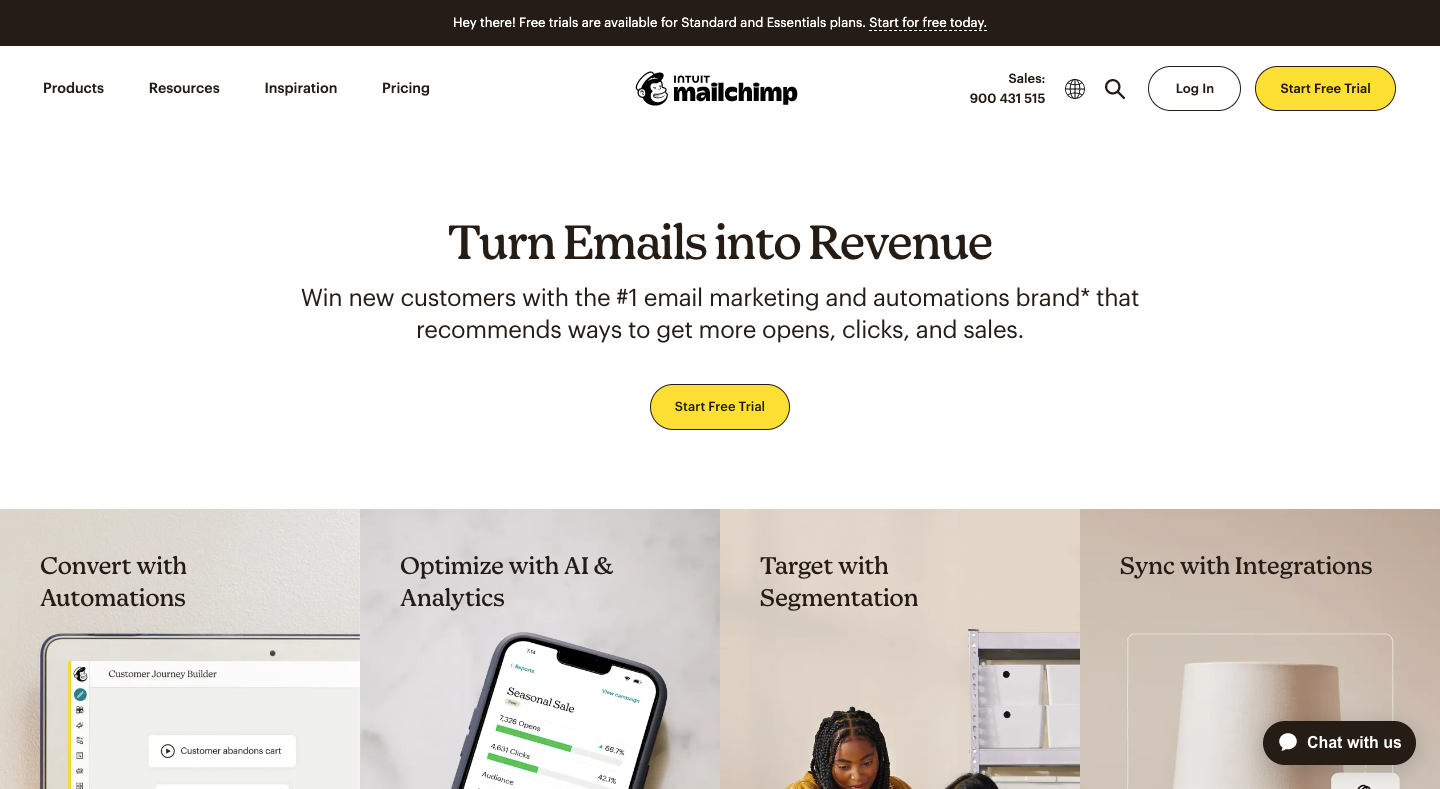 Mailchimp is the world’s most popular platform when it comes to email marketing, with an impressive 67 percent market share. Thousands of businesses rely on its automated services to send emails and expand their reach. Currently, there are over 12 million users benefiting from Mailchimp's tools.
Mailchimp is the world’s most popular platform when it comes to email marketing, with an impressive 67 percent market share. Thousands of businesses rely on its automated services to send emails and expand their reach. Currently, there are over 12 million users benefiting from Mailchimp's tools.
What Makes Mailchimp the Best ActiveCampaign Alternative?
- Easy to master. Perhaps Mailchimp’s strongest suit is its ease of use. Even non-marketers can use the platform to engage and grow their audience. ActiveCampaign is a more advanced tool with a far steeper learning curve.
- Built for email. Mailchimp is first and foremost an email marketing platform, whereas ActiveCampaign has a lot more strings to its bow (and is consequently harder to use). If all you’re looking for is a tool to power and optimize your email campaigns, Mailchimp is a lot easier to master.
- Generous free product tier. Mailchimp has axed some of the features from its free tier in recent months, but it’s still pretty comprehensive, offering up to 500 contacts and 1,000 monthly email sends. ActiveCampaign doesn’t offer any free functionality beyond the 14-day trial.
- Free landing page builder. ActiveCampaign’s landing page tools are only available at “Plus” level and above, whereas all Mailchimp customers—even those on the free tier—can use its landing page and form builder.
How Does Mailchimp Compare to ActiveCampaign?
| Mailchimp | ActiveCampaign | |
| Best Feature | Advanced analytics and reporting help marketers make data-driven decisions. | Predictive actions use machine learning to deliver customer experiences based on data, such as the best time to send emails. |
| Best For | Small businesses | Advanced marketers who need high-level automation |
| Pros | A generalist email automation platform that’s easy to use. | Purpose-built CRM connects your sales and marketing activities. |
| Cons | Lacks attractive features like a built-in CRM. | Harder to use (and no free product tier to learn the ropes). |
| Pricing/Month | Free for up to 500 contacts and 1,000 monthly email sends; paid plans start at $9.99 per month for 500 contacts and 5,000 monthly email sends. | From $29 per month for one user and unlimited emails. |
| Support | Paid plans include 24/7 support via chat and email. Phone and priority support is only available to Premium customers paying $350+ per month. | All ActiveCampaign plans offer 24/7 email and chat-based support, but only Enterprise customers get over-the-phone support. |
4. Omnisend
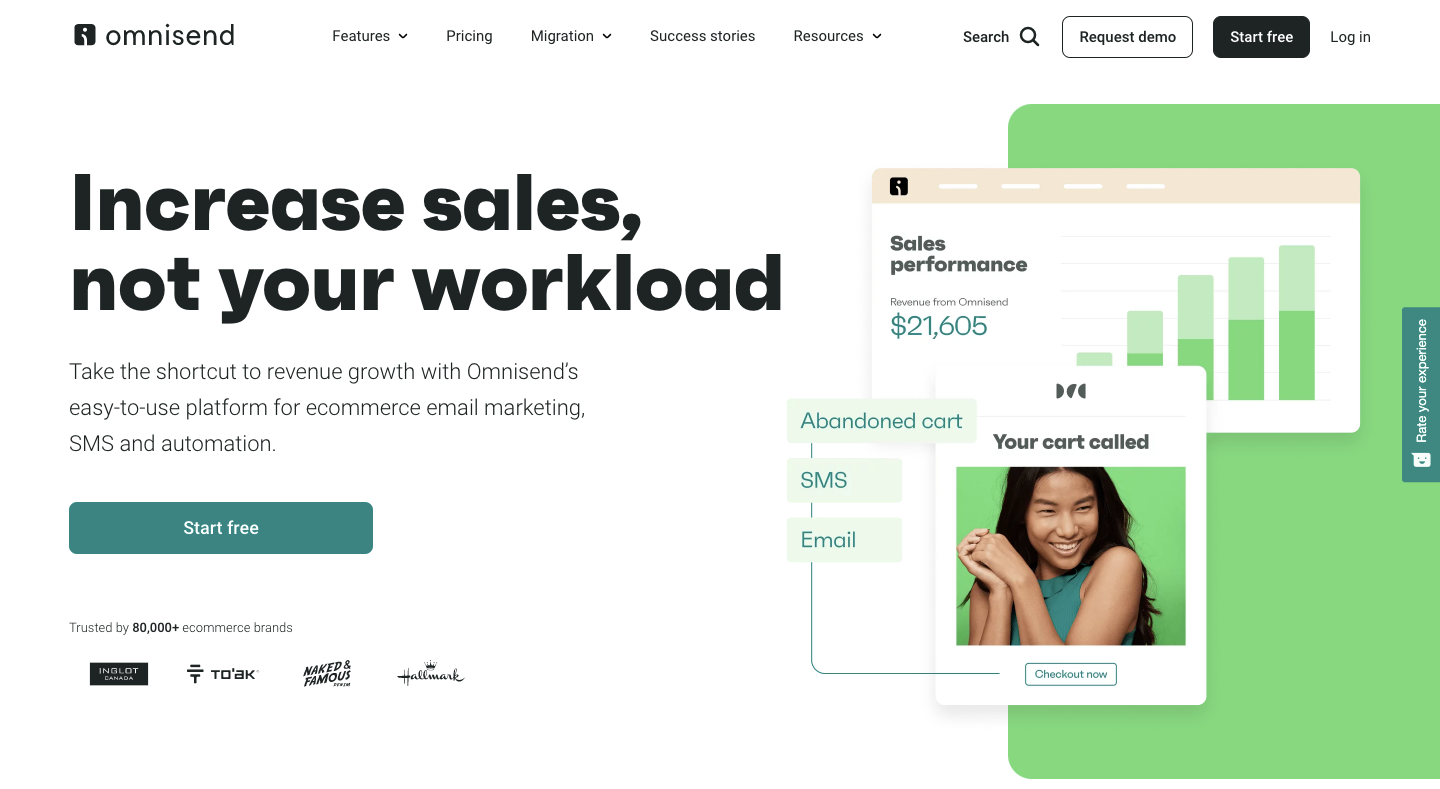
Omnisend is a marketing automation tool for ecommerce stores. Over 80,000 stores use the platform for email and SMS campaigns to increase engagement and conversion rates.
What Makes Omnisend the Best ActiveCampaign Alternative?
- Tons of free functionality. Omnisend provides a wealth of free features. Free subscribers can reach up to 250 contacts per month via up to 500 monthly email sends, 60 SMS messages, and 500 web push notifications. This one’s an open-and-shut case, because ActiveCampaign doesn’t offer a free product tier.
- Ecommerce-friendly UI. As with Drip and Klaviyo, Omnisend is a dedicated ecommerce automation platform, with a feature set designed solely for ecommerce brands. ActiveCampaign can do all the same stuff—but because it also serves over a dozen other industries, its user interface feels more cluttered.
- Less money, more contacts. At both the lower and upper ends of the audience spectrum, Omnisend is cheaper. It charges $20/month for up to 1,000 contacts, whereas ActiveCampaign charges $29+ per month. And if you’ve got up to 50,000 contacts, you’ll be paying $330/month with Omnisend—that’s almost $230/month cheaper than ActiveCampaign’s most similar package.
- Customized support. Omnisend users at Pro level and above can access a dedicated customer success manager to help optimize their campaigns. Meanwhile, ActiveCampaign customers below Enterprise level can’t even pick up the phone to speak to a support agent.
How Does Omnisend Compare to ActiveCampaign?
| Omnisend | ActiveCampaign | |
| Best Feature | Web push notifications allow brands to instantly retarget customers. | Predictive actions use machine learning to deliver customer experiences based on data, such as the best time to send emails. |
| Best For | Ecommerce marketers | Advanced marketers who need high-level automation |
| Pros | Easy-to-master ecommerce automations. | Does all the same stuff, plus lots of other nice-to-haves, including a built-in CRM. |
| Cons | Lacks some of ActiveCampaign’s more advanced features. | More cluttered UI and no free product tier makes for a steeper learning curve. |
| Pricing/Month | Free to reach up to 250 contacts per month, including 500 monthly email sends, up to 60 SMS messages, and up to 500 web push notifications. Paid plans start at $16 per month to reach up to 500 contacts (including unlimited push notifications). | From $29 per month for one user and unlimited emails. |
| Support | All users get 24/7 email and live chat support, while Pro and Enterprise subscribers also get a dedicated customer success manager. | All ActiveCampaign plans offer 24/7 email and chat-based support, but only Enterprise customers get over-the-phone support. |
5. AWeber
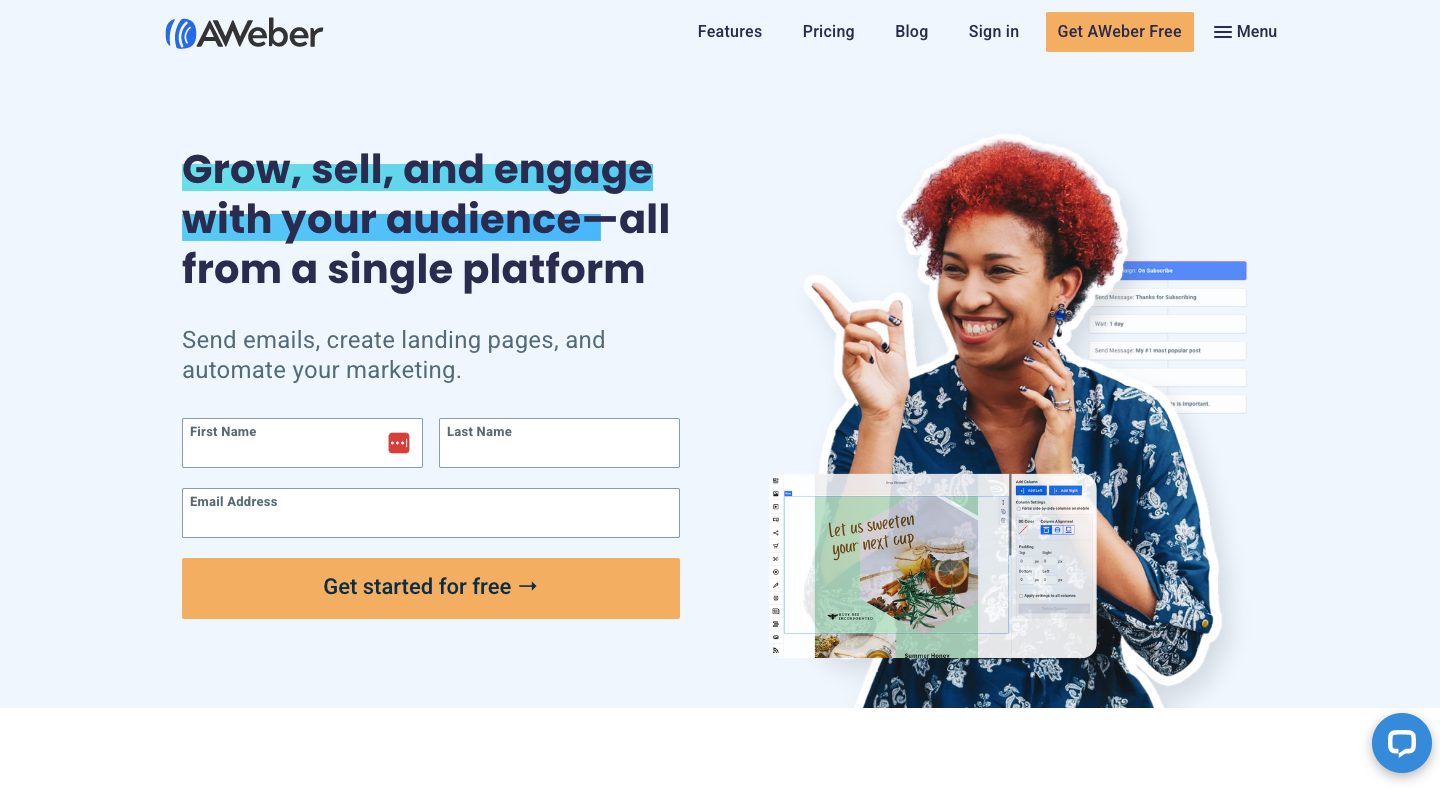
AWeber is a marketing tool predominantly geared toward entrepreneurs and small businesses. It’s got powerful features such as email campaign management, a landing page builder, and automated marketing strategies. And it also offers forms so you can collect customer data conveniently.
What Makes AWeber the Best ActiveCampaign Alternative?
- More email templates. AWeber offers one of the largest selections of email marketing and newsletter templates of any tool we’ve seen, at more than 600. ActiveCampaign, by comparison, has a library of 250+ templates—still plenty, but not in AWeber’s league.
- More landing page templates, too. At the time of writing, AWeber’s template library includes close to 150 templates—about three times more than ActiveCampaign—spanning over 100 industries.
- Free for life. It should be clear by now that ActiveCampaign doesn’t have a free product tier. AWeber does—and it’s pretty generous, including up to 500 email subscribers and 3,000 monthly email sends.
- Phone-based support (even at low product tiers). Only ActiveCampaign Enterprise customers get the option to pick up the phone and speak to customer support, whereas AWeber offers phone-based support across all product tiers—even to free users (albeit paying customers get priority).
How Does AWeber Compare to ActiveCampaign?
| AWeber | ActiveCampaign | |
| Best Feature | Create email templates in seconds using your website or Facebook page URL. | Predictive actions use machine learning to deliver customer experiences based on data, such as the best time to send emails. |
| Best For | Startups and small businesses | Advanced marketers who need high-level automation |
| Pros | More email and landing page templates. | (Far) more advanced automations and more sophisticated reporting. |
| Cons | Lacks advanced functionality, like sophisticated automations. | Fewer templates and no free product tier. |
| Pricing/Month | Free for up to 500 email subscribers and 3,000 monthly email sends; paid plans priced from $16.15 per month for up to 2,500 subscribers. | From $29 per month for one user and unlimited emails. |
| Support | All users—even free subscribers—can access 24/7 live support via phone, email, and chat (although paying customers are placed in a priority queue). | All ActiveCampaign plans offer 24/7 email and chat-based support, but only Enterprise customers get over-the-phone support. |
6. ConvertKit
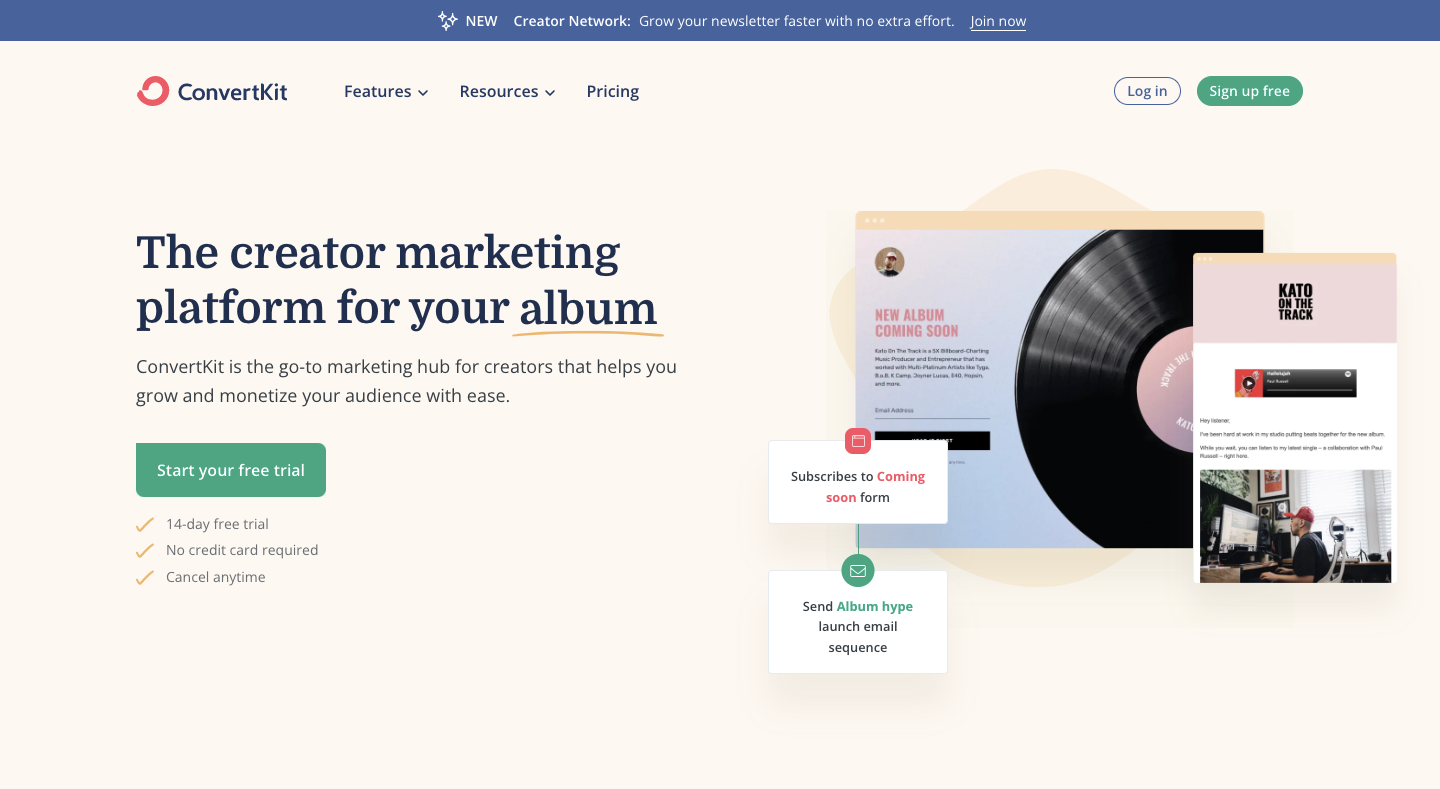
ConvertKit is a marketing tool built with content creators in mind. It provides a variety of features like landing page and form designers, emailing capabilities, and an automation builder. Over 560,000 creators have already used the platform to reach over 600 million users worldwide.
What Makes ConvertKit the Best ActiveCampaign Alternative?
- Designed for creators. ConvertKit is built with creators in mind, from authors and coaches to musicians and podcasters. It offers all the tools this audience requires to reach and grow an audience, without any of the less-relevant stuff on ActiveCampaign. This makes it easier to use.
- Built-in referral program. Referral marketing is a powerful strategy for creators looking to grow an audience. ConvertKit has a built-in referral program, allowing customers to leverage this functionality out of the box. It’s possible to run referral marketing through ActiveCampaign, but you’ll need to integrate with a separate tool (like SparkLoop). And that’ll cost you more money.
- Free product tier. We’re starting to sound like a broken record now, but ActiveCampaign has no free product tier, whereas ConvertKit lets you add up to 1,000 contacts and send unlimited emails free of charge. Not a big deal if you’ve got a substantial mailing list, but a little free functionality is always nice to have.
- Monetize through sponsorships. Another area in which ConvertKit’s creator-focused tools come to the fore: the platform helps newsletter creators land advertiser sponsorships (provided they have 10,000+ subscribers and send newsletters at least once a week). ActiveCampaign doesn’t offer anything similar.
How Does ConvertKit Compare to ActiveCampaign?
| ConvertKit | ActiveCampaign | |
| Best Feature | Integrated newsletter referral program helps creators grow their reach by leveraging their existing audience. | Predictive actions use machine learning to deliver customer experiences based on data, such as the best time to send emails. |
| Best For | Content creators | Advanced marketers who need high-level automation |
| Pros | Easy-to-use engagement and monetization tools for content creators. | Vastly superior automations and reporting. |
| Cons | Very basic reporting, with no bounce rate, geographical data, or click maps. | Lacks built-in, creator-specific features like referral marketing and a sponsor network. |
| Pricing/Month | Free for up to 1,000 subscribers and unlimited email sends; paid plans start at $9 per month for up to 300 subscribers and unlimited sends. | From $29 per month for one user and unlimited emails. |
| Support | Paying customers get live chat and email support, with priority access offered to Creator Pro subscribers. Free subscribers only get community support. | All ActiveCampaign plans offer 24/7 email and chat-based support, but only Enterprise customers get over-the-phone support. |
7. Sendinblue
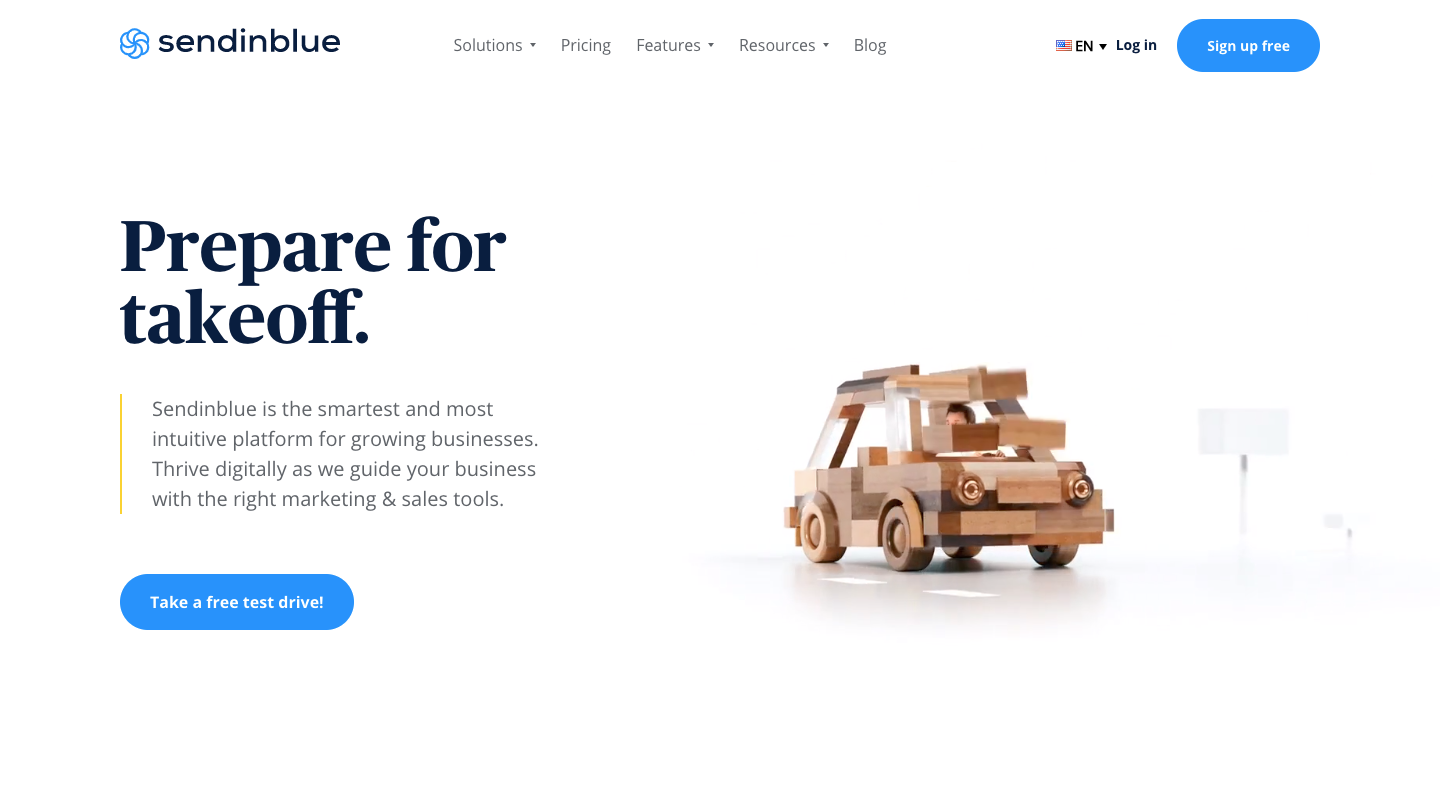 Sendinblue is a comprehensive marketing platform utilized by 500,000 customers in 180 countries, delivering 200 million emails per day. It offers various services such as emailing, SMS messaging, WhatsApp messaging, lead capture forms, Facebook Ads management, and automation tools.
Sendinblue is a comprehensive marketing platform utilized by 500,000 customers in 180 countries, delivering 200 million emails per day. It offers various services such as emailing, SMS messaging, WhatsApp messaging, lead capture forms, Facebook Ads management, and automation tools.
What Makes Sendinblue the Best ActiveCampaign Alternative?
- Extensive free functionality. Sendinblue might offer the most generous free product tier of any email marketing platform, allowing non-paying users to send 300 emails a day to unlimited contacts. ActiveCampaign, on the other hand, doesn’t have a free tier.
- Cheaper paid plans. Sendinblue also provides superb value to paying customers. To give a side-by-side comparison, $49 per month with Sendinblue gets you 60,000 monthly emails to unlimited contacts. With ActiveCampaign, the same money buys you unlimited emails, but only 2,500 contacts.
- Built-in support for transactional emails. Transactional emails are a vital part of running an ecommerce business. Sendinblue offers transactional emails as standard on all plans, even the free tier, and guarantees 97 percent deliverability. By contrast, you’ll need a separate integration—with an additional price tag—to send transactional emails through ActiveCampaign.
- Free CRM. That’s right: Sendinblue offers a totally free sales CRM, including unlimited contacts, pipeline management, automations, and more. With ActiveCampaign, you’d have to bundle the CRM and marketing products, which will set you back at least $$93/month.
How Does Sendinblue Compare to ActiveCampaign?
| Sendinblue | ActiveCampaign | |
| Best Feature | Send transactional emails with guaranteed 97 percent deliverability. | Predictive actions use machine learning to deliver customer experiences based on data, such as the best time to send emails. |
| Best For | Low-budget email marketing | Advanced marketers who need high-level automation |
| Pros | Includes transactional emails and a CRM with all product tiers. | More ecommerce integrations and more sophisticated functionality. |
| Cons | Offers fewer integrations than ActiveCampaign (and doesn’t integrate with BigCommerce). | More expensive and requires separate integrations for transactional emails. |
| Pricing/Month | Free for unlimited contacts and up to 300 emails per day. Paid plans start at $25 per month for unlimited contacts and 20,000 emails per month. | From $29 per month for one user and unlimited emails. |
| Support | The $25+ per month Starter plan only offers email-based support. To receive personalized support, you’ll need to subscribe to an Enterprise plan. | All ActiveCampaign plans offer 24/7 email and chat-based support, but only Enterprise customers get over-the-phone support. |
8. Constant Contact
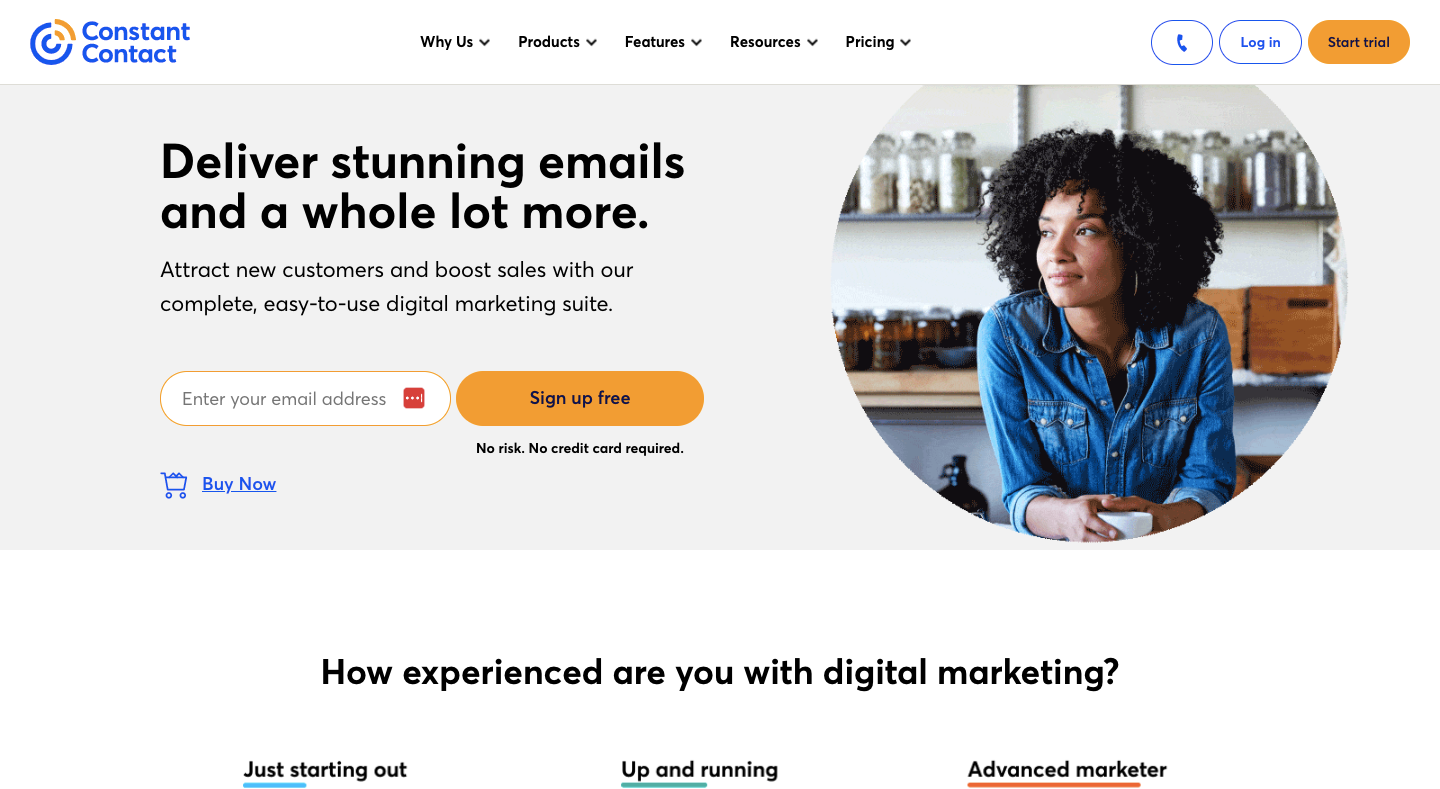 Constant Contact is a digital marketing automation platform aimed at small businesses. It offers email, SMS, social media, and automation services, and has a discounted rate for nonprofits—making it an attractive choice for organizations in the third sector.
Constant Contact is a digital marketing automation platform aimed at small businesses. It offers email, SMS, social media, and automation services, and has a discounted rate for nonprofits—making it an attractive choice for organizations in the third sector.
What Makes Constant Contact the Best ActiveCampaign Alternative?
- Bigger discount for nonprofits. Both Constant Contact and ActiveCampaign provide discounts for charities and nonprofits, but Constant Contact’s is more generous (30 percent vs. 20 percent).
- Cheaper pricing. Full disclosure: in our view, Constant Contact isn’t particularly cheap given its comparative lack of functionality. But if you’re just looking to send a bunch of emails, it’s definitely cheaper than ActiveCampaign. For comparison, $35/month gets you 2,500 contacts and 60,000 monthly emails with Constant Contact; ActiveCampaign’s most similar plan costs $49 per month (but it does include unlimited emails).
- Built-in social scheduling. Although it’s predominantly an email tool, Constant Contact offers some helpful extras, including the ability to create social ads and schedule organic posts from within the platform. You can do that with ActiveCampaign, too—but you need a separate integration.
- Phone-based support. All Constant Contact customers can speak to the support team over the phone—a privilege that’s only offered to Enterprise-level ActiveCampaign users. Personalized consultations are also available to Constant Contact Plus subscribers.
How Does Constant Contact Compare to ActiveCampaign?
| Constant Contact | ActiveCampaign | |
| Best Feature | Manage campaigns on the go from a dedicated mobile app. | Predictive actions use machine learning to deliver customer experiences based on data, such as the best time to send emails. |
| Best For | Nonprofits and charities | Advanced marketers who need high-level automation |
| Pros | (Slightly) cheaper plans and built-in social scheduling. | Far more advanced features; much stronger reporting and automations. |
| Cons | Limited reporting, with no geo tracking, click maps, or social media reports. | Costs a little more. |
| Pricing/Month | From $9.99 per month for up to 500 contacts and 12,000 monthly email sends. | From $29 per month for one user and unlimited emails. |
| Support | Both paid plans offer live chat and phone support, while Constant Contact Plus subscribers also get personalized consultations to improve performance. | All ActiveCampaign plans offer 24/7 email and chat-based support, but only Enterprise customers get over-the-phone support. |
9. GetResponse
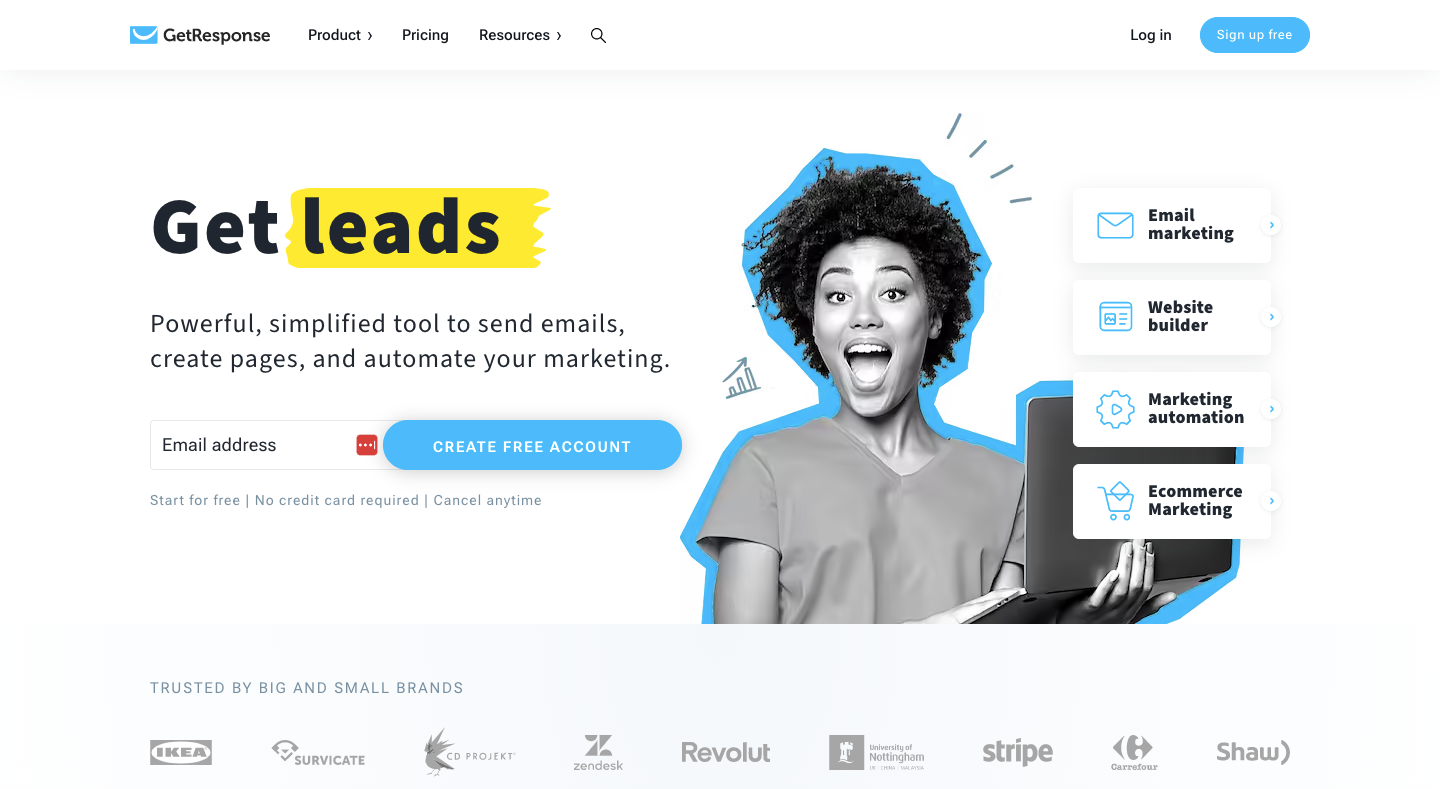 GetResponse is an email marketing platform that offers extra features such as automation, SMS marketing, and web push notifications to its premium customers. It’s been used by over 350,000 businesses, including big names like Ikea, Stripe, and Zendesk.
GetResponse is an email marketing platform that offers extra features such as automation, SMS marketing, and web push notifications to its premium customers. It’s been used by over 350,000 businesses, including big names like Ikea, Stripe, and Zendesk.
What Makes GetResponse the Best ActiveCampaign Alternative?
- Unparalleled email deliverability. GetResponse sits proudly at the top of the tree in Email Deliverability Report’s email marketing provider ranking. ActiveCampaign only fares fractionally worse—but if deliverability is your main concern, GetResponse is hard to beat.
- More meaningful inbox testing. Coupled with its superb email deliverability, GetResponse provides solid inbox testing tools, scoring emails from 0 – 5 based on how likely they are to avoid the spam folder. ActiveCampaign does spam testing, too, but it only awards a “pass” or “fail” rating, with no way to interpret your score.
- Free functionality. Guess what? ActiveCampaign doesn’t have a free product tier. GetResponse does, and it’s pretty generous. Free users can send 2,500 monthly emails to up to 500 contacts, and they also get to access GetResponse’s HTML editor, click tracking, and a few other tasty features.
- Integrated webinar hosting. Out of the box, GetResponse Marketing Automation, Ecommerce Marketing, and MAX2 customers can take advantage of the platform’s built-in webinar hosting functionality. It’s a relatively niche feature, but certainly nice to have if webinars are part of your marketing strategy. ActiveCampaign requires a third-party integration to run webinars, which carries an additional cost.
- Build landing pages cheaper. Both platforms offer excellent landing page builders, but ActiveCampaign’s is only available at Plus level and above (priced from $49/month). By contrast, even free users can access the GetResponse landing page builder (albeit with a few usage limitations).
How Does GetResponse Compare to ActiveCampaign?
| GetResponse | ActiveCampaign | |
| Best Feature | Built-in support for live and on-demand webinars. | Predictive actions use machine learning to deliver customer experiences based on data, such as the best time to send emails. |
| Best For | Small businesses that need advanced marketing tools | Advanced marketers who need high-level automation |
| Pros | Superb email deliverability and spam-checking tools. | More comprehensive reporting, including chat conversion, automation reports, and contact trends. |
| Cons | No marketing automation features in the entry-level paid plan. | Less sophisticated spam testing. |
| Pricing/Month | Free for up to 500 contacts and 2,500 monthly email sends. Paid plans start at $15.58 per month for 1,000 contacts and unlimited email sends. | From $29 per month for one user and unlimited emails. |
| Support | Paid plans include 24/7 support via chat and email. Phone support is only available at top-tier MAX2 level; some MAX2 customers can also access Slack support. | All ActiveCampaign plans offer 24/7 email and chat-based support, but only Enterprise customers get over-the-phone support. |
10. HubSpot
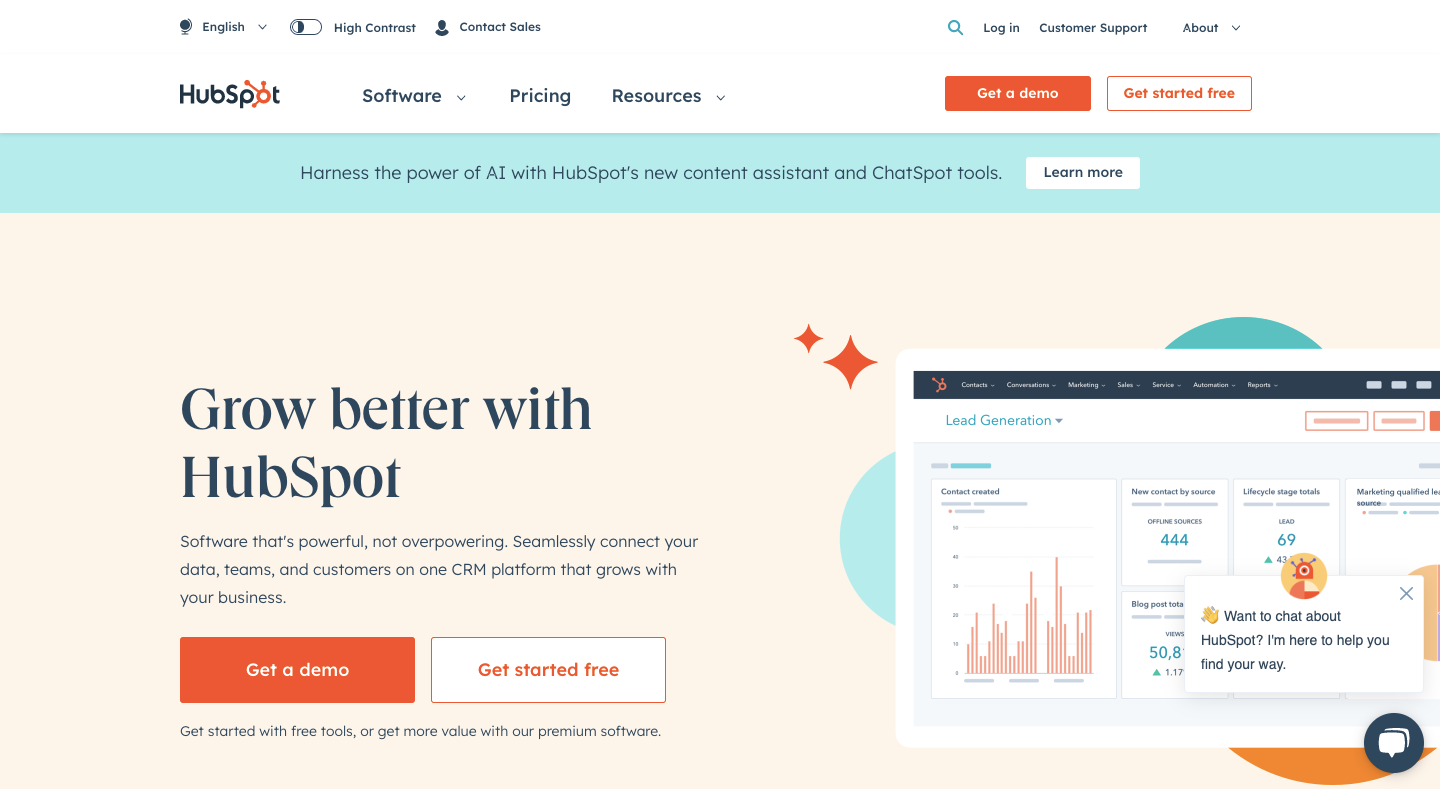 HubSpot is a wide-ranging automation platform that incorporates a CRM, email marketing tools, a landing page builder, and much more. With HubSpot, customers can pick and choose its products or go for an all-in-one inbound marketing solution. It has over 167,000 customers in more than 120 countries, including renowned brands like DoorDash and Soundcloud.
HubSpot is a wide-ranging automation platform that incorporates a CRM, email marketing tools, a landing page builder, and much more. With HubSpot, customers can pick and choose its products or go for an all-in-one inbound marketing solution. It has over 167,000 customers in more than 120 countries, including renowned brands like DoorDash and Soundcloud.
What Makes HubSpot the Best ActiveCampaign Alternative?
- Solid free plan. HubSpot gives you unlimited contacts and 2,000 monthly email sends without asking for a cent in return, whereas ActiveCampaign doesn’t offer a free plan. So this one’s a slam-dunk for HubSpot.
- Integrate with (basically) everything. Neither platform is short on integrations, and unless you have extremely niche requirements, you’ll be totally fine with either. But this is ultimately a numbers game, and HubSpot offers slightly more than ActiveCampaign (1,000+ vs. 910+ at the time of writing).
- Built-in social media posting. HubSpot Marketing Hub Professional allows users to connect up to 50 social accounts, publish 10,000 posts a month, and schedule content three years ahead of time. If you want to do social media scheduling in ActiveCampaign, you’ll need a third-party integration.
- More landing page templates. When we checked, HubSpot offered a staggering 347 landing page templates tailored to different industries and use cases. There’s certainly nothing wrong with ActiveCampaign’s landing page templates—it just has far fewer of them.
- Free CRM. HubSpot is arguably best known as a customer relationship management tool, and it lets you use (some of) its CRM tools free of charge, helping you create more personalized customer experiences. ActiveCampaign has an excellent CRM, too, but you’ll need to pay for the privilege of using it.
How Does HubSpot Compare to ActiveCampaign?
| HubSpot | ActiveCampaign | |
| Best Feature | Connect marketing, sales, content management, and customer service in a single platform. | Predictive actions use machine learning to deliver customer experiences based on data, such as the best time to send emails. |
| Best For | B2B inbound marketing | Advanced marketers who need high-level automation |
| Pros | An all-in-one sales and marketing platform with an excellent (free) CRM. | More sophisticated automations at a lower price point. |
| Cons | Expensive subscriptions and high onboarding fees. | No free functionality and a narrower feature set. |
| Pricing/Month | Free marketing plan includes unlimited contacts and 2,000 monthly email sends. Paid marketing plans start at $18 per month for 1,000 contacts and 5,000 monthly sends. | From $29 per month for one user and unlimited emails. |
| Support | Paying customers can get 1:1 email and in-app chat support. Phone support is available at Pro level and above. | All ActiveCampaign plans offer 24/7 email and chat-based support, but only Enterprise customers get over-the-phone support. |
Frequently Asked Questions
ActiveCampaign is a superb tool that fares consistently well in side-by-side comparisons thanks to its highly sophisticated automations. As an all-round marketing automation platform, it’s hard to beat. But there are definitely better ActiveCampaign alternatives available for certain businesses. For instance, if you’re in ecommerce, you’re (probably) better off with a dedicated platform like Drip, Klaviyo, or Omnisend.
In a word: no. While Google doesn’t have its own marketing automation platform, it’s possible to transform Gmail into a basic email marketing tool through third-party integrations.
Perhaps. It’s an excellent all-rounder, with some of the most sophisticated automations on the market. And despite its wealth of features, it’s pretty easy to learn the ropes. But whether it’s the “best” platform depends on the specific requirements of your business. Ecommerce-specific solutions like Drip, Klaviyo, and Omnisend are a better fit for (most) ecommerce brands, while cheaper options like Sendinblue make more sense for smaller, more budget-conscious businesses.
There are few clear drawbacks to ActiveCampaign—it really is a terrific platform. Its only real weakness is that it hasn’t “niched down”, instead preferring to serve dozens of industries. So while there’s arguably no better all-round marketing automation platform, there might be a better industry-specific solution for your business.
Conclusion
All-rounders like ActiveCampaign aren’t right for everyone.
Realistically, you’re going to pay for a lot of functionality designed for one of the dozens of other niches it serves. And you’ll miss out on some of the more attractive features of an industry-specific platform.
That’s why we truly believe Drip is a better match for ecommerce brands (especially DTCs).
But don’t take our word for it. Find out for yourself by signing up for your 14-day free trial today.


